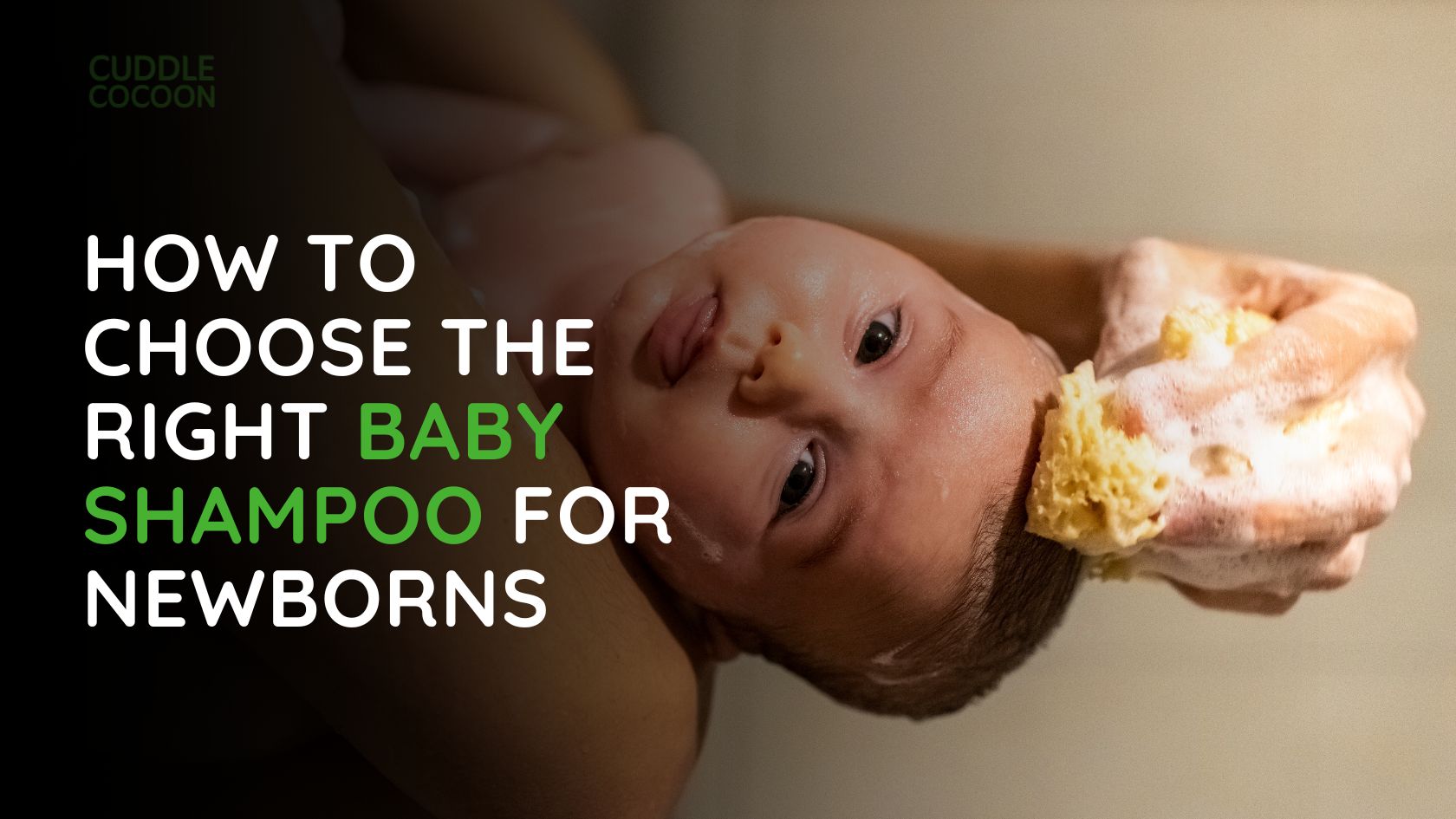Choosing the right baby shampoo can feel overwhelming — especially for first-time parents. Your baby’s delicate scalp and ultra-sensitive skin need the gentlest care possible, and not all products on the shelf meet that standard.
At Cuddle Cocoon, we believe in simple, natural baby care. This guide will help you understand how to choose the best baby shampoo for newborns, what ingredients to avoid, and what makes a baby shampoo truly safe and nourishing.
Why You Should Use a Baby-Specific Shampoo
You might wonder — why can’t I use my regular shampoo on my baby?
A newborn’s skin is thinner, more absorbent, and more prone to irritation than adult skin. Regular shampoos contain harsh cleansers and fragrances that can lead to:
- Dryness
- Allergic reactions
- Eye irritation
- Disrupted scalp pH
Baby shampoos are specially formulated to be:
- Tear-free
- Mild and pH balanced
- Free from harsh detergents and sulfates
- Hypoallergenic and dermatologist-tested
When Should You Start Shampooing a Newborn’s Hair?
Most newborns don’t need daily hair washing. In fact, 2–3 times a week is more than enough unless your baby has cradle cap or sweats a lot.
Use only warm water and a few drops of gentle baby shampoo in the first few weeks. Be careful around the soft spot (fontanelle) on their head and always support the neck during bath time.
What to Look for in a Newborn Baby Shampoo
1. Tear-Free Formula
Newborns blink reflexively, and even a tiny drop of harsh shampoo can cause pain and discomfort. A tear-free baby shampoo ensures the formula doesn’t sting the eyes and keeps bath time stress-free.
2. Free from Harsh Chemicals
Always look for shampoos that are free from:
- Sulfates (SLS/SLES): These are strong foaming agents that strip natural oils and can irritate baby skin.
- Parabens & Phthalates: Synthetic preservatives and fragrances linked to hormone disruption.
- Artificial Fragrance & Dyes: These can trigger allergies and skin issues in sensitive babies.
Instead, choose shampoos that use natural essential oils or botanical extracts for a mild, soothing scent — or no added fragrance at all.
3. pH-Balanced for Baby Scalp
Newborn scalps are delicate and still developing their acid mantle (a protective layer on the skin). A good baby shampoo maintains a neutral pH (around 5.5) to avoid disrupting this barrier.
4. Natural & Organic Ingredients
Ingredients like aloe vera, calendula, chamomile, and coconut-based cleansers offer hydration, calm the scalp, and prevent dryness — without the risks associated with synthetic chemicals.
Cuddle Cocoon’s upcoming range includes Softsuds™ Baby Shampoo made with botanical blends that gently cleanse while maintaining your baby’s natural skin balance.
Ingredients to Love (and Why)
Let’s look at baby-safe ingredients that are beneficial:
- Aloe Vera: Soothes irritation and hydrates the scalp
- Chamomile: Naturally calming and anti-inflammatory
- Coconut-based surfactants: Gentle cleansers derived from coconuts
- Calendula Extract: Heals dry or flaky patches, perfect for cradle cap
- Oat Protein: Adds softness and a protective layer
These ingredients are not just gentle — they support your baby’s developing skin microbiome and scalp health.
Ingredients to Avoid in Baby Shampoo
Be a label detective! Watch out for these red flags:
- Sodium Lauryl Sulfate (SLS) or Sodium Laureth Sulfate (SLES)
- Parabens (methylparaben, ethylparaben)
- Formaldehyde-releasing preservatives (like DMDM hydantoin)
- Artificial colors (CI followed by numbers)
- Synthetic fragrances (listed as “Fragrance” or “Parfum”)
A truly gentle baby shampoo should use plant-based cleansers and skip unnecessary fillers or toxins.
Pro Tips for Bath Time Success
A good shampoo matters, but so does the bathing technique. Here’s how to make bath time safe and fun:
- Use lukewarm water (around 37–38°C)
- Wet your baby’s hair gently using your hand or a soft mug
- Apply a few drops of shampoo — newborns don’t need a full pump
- Massage lightly with fingertips, especially behind ears and neck folds
- Rinse thoroughly with gentle pours of clean water
- Pat dry with a soft towel — no rubbing
Cuddle tip: Use a soft baby comb after drying to prevent tangles or cradle cap buildup.
Can Baby Shampoo Help With Cradle Cap?
Cradle cap is a common scalp condition in newborns that causes flaky, oily patches. It’s harmless and temporary — but it can look worrying.
Choose a gentle baby shampoo with natural antifungal ingredients like tea tree, neem, or chamomile. These help loosen flakes and soothe inflammation without drying the scalp.
Massage with natural baby oil before the bath, and then gently wash with baby shampoo 2–3 times a week to reduce buildup.
Why Cuddle Cocoon Is Creating Softsuds™ Baby Shampoo
As parents ourselves, we know how confusing product labels can be. That’s why we’re working on Softsuds™ Baby Shampoo — a natural, sulfate-free formula created specifically for newborns.
Here’s what you can expect:
- Tear-free and ultra-gentle
- 100% plant-based cleansing agents
- Free from toxins, parabens, and synthetic fragrances
- Infused with calendula, aloe vera & oat protein
- Safe for daily use from Day 1
Every bottle is made with love — tested by real moms and approved for baby’s most sensitive days.
How Often Should You Wash a Baby’s Hair?
Newborns don’t need daily shampooing unless:
- They have cradle cap
- Their hair gets visibly dirty (milk spills, sweat, etc.)
- It’s hot and humid outside
2–3 times a week is ideal for most babies under 6 months. Over-washing can strip their natural scalp oils and lead to dryness.
Final Thoughts: Keep It Simple, Keep It Safe
When it comes to baby care, less is more. Choose a baby shampoo that:
- Has safe, natural ingredients
- Is dermatologist-approved
- Avoids artificial irritants
- Respects your baby’s skin and hair balance
Your baby deserves a product as gentle as your touch — and your peace of mind is priceless.
As you build your newborn’s care routine, Cuddle Cocoon is here to offer honest, natural solutions — without compromise.
Looking for newborn skincare tips too? Read our blog on natural baby skin care routines →

